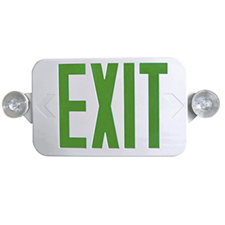
Lighting Up Your Options for Emergency Exit Fixtures
Chuck Ross
Emergency exit lights might seem to be a bit of a commodity – after all, standardization is built into their design through a range of building code regulations at federal, state and local levels. However, contractors do need to pay attention to the color of these lights when evaluating options. While red remains the predominant color across most of the country, green exit lights, long popular in parts of Asia and Europe, are becoming standard in more jurisdictions here. Deciding on which would be better for any specific project depends on a number of factors:
The addition of an image of a stick figure running through a doorway is another option popular overseas that’s becoming more prevalent in U.S. buildings. This could be especially helpful in settings where non-English speakers could be at risk. New York City codes now require buildings 75 ft. or taller include the design on all fire doors in addition to red exit signs directing occupants to the nearest stairwell.
- Local regulations. Color choice might already be written into your state’s building codes. While most state regulations allow for either, some (like Georgia and Illinois) require red, while others (like Maryland and Utah) mandate green. A larger number of states recommend one or the other color.
- Visibility. Red and green are both highly visible colors, but that visibility can shift based on the environment. Red is usually easier to see in low-light settings and where there’s lots of smoke and dust. Green is easier to see in well-lit spaces with lots of natural light.
- Cultural considerations. Advocates for green exit lights also emphasize cultural associations regarding the two colors. In driving, for example, the color red is an instant cue for stopping, and on a manufacturing floor, spinning red lights are a sign of a hazardous location. Green, on the other hand, is used to signal drivers to proceed and can connote safety in other settings. So, from a distance, just seeing a green light could provide important safety guidance, even if an occupant can’t make out the letters, themselves.
The addition of an image of a stick figure running through a doorway is another option popular overseas that’s becoming more prevalent in U.S. buildings. This could be especially helpful in settings where non-English speakers could be at risk. New York City codes now require buildings 75 ft. or taller include the design on all fire doors in addition to red exit signs directing occupants to the nearest stairwell.
Photo courtesy of TCP Lighting





